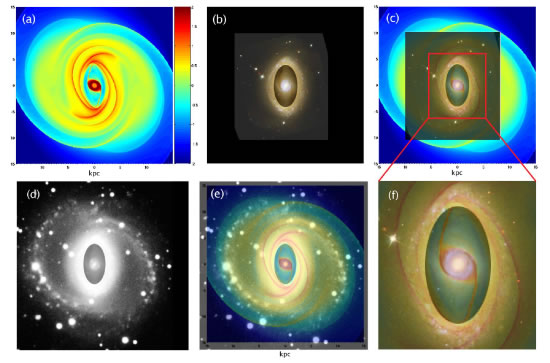研究成果藝廊 > 計算天文物裡計畫(CompAS)
研究成果藝廊
計算天文物裡計畫(CompAS)
| Hydrodynamical Simulations of the Barred Spiral Galaxy NGC 6782 |
|
圖片來源: Lien-Hsuan Lin, Chi Yuan and R. Buta

Numerical calculations reveal that the striking features in NGC 6782 can be reproduced provided that the gas flow is governed by the gravitational potential associated with a slowly rotating strong bar.
|
| NGC 6782 is an early-type barred spiral galaxy exhibiting a rich and complex morphology with multiple ring patterns. To provide a physical understanding of its structure and kinematical properties, two-dimensional hydrodynamical simulations have been carried out. Numerical calculations reveal that the striking features in NGC 6782 can be reproduced provided that the gas flow is governed by the gravitational potential associated with a slowly rotating strong bar. In particular, the response of the gaseous disk to the bar potential leads to the excitation of spiral density waves at the inner Lindblad resonance giving rise to the appearance of a nearly circular nuclear ring with a pair of dust lanes. For a sufficiently strong bar potential, the inner 4:1 spiral density waves are also excited. The interaction of the higher harmonic waves with the waves excited at the inner Lindblad resonance and confined by the outer Lindblad resonance results in the observed diamond-shaped (or pointy oval) inner ring structure. The overall gas morphology and kinematical features are both well reproduced by the model provided that the pattern speed of the bar is sim 25 km/s/kpc. (a) The projected density distribution of the simulation result. The color map denotes the surface density distribution in logarithmic scale. (b) Hubble Heritage multiple color image of NGC 6782 with the brightness of the pointed-oval inner ring enhanced. (c) Superposition of Figure(a) and Figure(b). The bright nuclear ring, off centered gas lanes, as well as the pointy oval inner ring in our model exhibit the same shapes and positions as the observation. (d) B-band image with the brightness enhanced except for the central part. (e) Superposition of Figure(a) and Figure(d). The two faint branches near the tip of the inner ring at the northwestern outer arm in the B-band image are also reproduced in our simulation result. (f) A close-up of the inner regions of Figure(c). Except Figure(f), all panels in this figure are of the same scale. (Lien-Hsuan Lin, Chi Yuan and R. Buta, 2008, ApJ, 684 1048) |
 asiaa.sinica.edu.tw 媒體連絡: epo
asiaa.sinica.edu.tw 媒體連絡: epo asiaa.sinica.edu.tw
asiaa.sinica.edu.tw